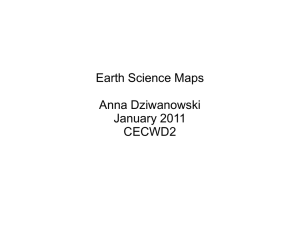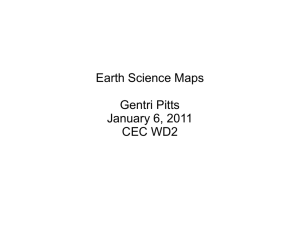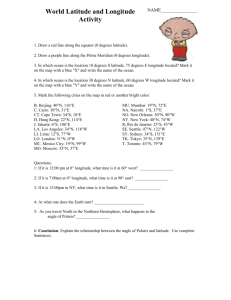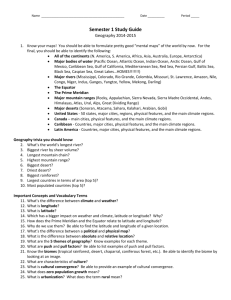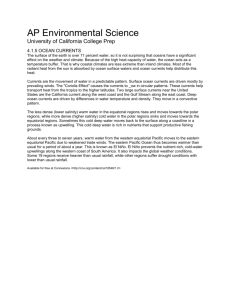Earth_Science_Maps - CEC Freshmen Showcase
advertisement
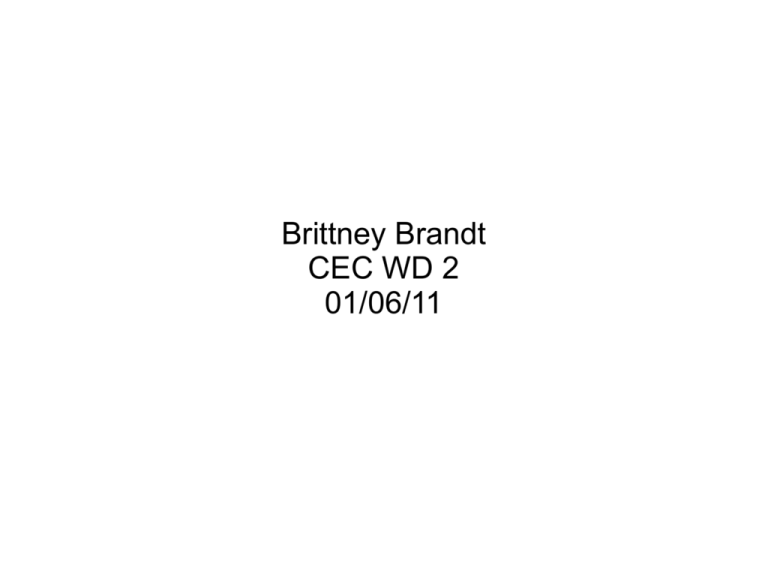
Brittney Brandt CEC WD 2 01/06/11 Table of Contents Continents Oceans Climate Zones & Latitude Global Wind Patterns Nike Shoe Investigation Continents North America Europe Asia Africa South America Australia Antarctica Oceans Artic Ocean Atlantic Ocean Pacific Ocean Pacific Ocean Indian Ocean Southern Ocean Latitude & Longitude SE T LA LO NY NO MC MO B Y C Atlantic Ocean H MU NA LI R CT X Indian Ocean TK J SY Latitude & Longitude 1. Draw a red line along the equator (0 degrees latitude). 2. Draw a purple line along the Prime Meridian (0 degrees longitude). 3. In which ocean is the location 10 degrees S latitude, 75 degrees E longitude located? Mark it on the map with a blue "X" and write the name of the ocean. 4. In which ocean is the location 30 degrees N latitude, 60 degrees W longitude located? Mark it on the map with a blue "Y" and write the name of the ocean. Latitude & Longitude Cont. 5. Mark the following cities on the map in red: B. Beijing: 40°N, 116°E C. Cairo: 30°N, 31°E CT. Cape Town: 34°S, 18°E H. Hong Kong: 22°N, 114°E J. Jakarta: 6°S, 106°E LA. Los Angeles: 34°N, 118°W LI. Lima: 12°S, 77°W LO. London: 51°N, 0°W MC. Mexico City: 19°N, 99°W MO. Moscow: 55°N, 37°E MU. Mumbai: 19°N, 72°E NA. Nairobi: 1°S, 37°E NO. New Orleans: 30°N, 90°W NY. New York: 40°N, 74°W R, Rio de Janeiro: 23°S, 43°W SE. Seattle: 47°N, 122°W SY. Sydney: 34°S, 151°E TK. Tokyo: 35°N, 139°E T. Toronto: 43°N, 79°W T. Toronto: 43°N, 79°W Climate Zones & Latitude Polar Zone 66.5°N-90°N Temperate Zone 23.5°N- 66.5° N Tropic Zone 23.5° N- 23.5° S Temperate Zone 23.5°S- 66.5° S Polar Zone 66.5°S-90°S Global Winds Patterns Polar Cells Rising Air Ferrell Cells Polar easterlies 60° N Sinking Air Westerlies 30° N Trade Winds 0°Hadley Cells Rising Air 30° S Westerlies Polar Easterlies 60° s Nike Shoe Investigation 1 4 7 3 2 3 5 6 8 9 10 Pacific Ocean Map 1 9 North Equatorial North Pacific 8 Equatorial Counter 4 7 5 3 3 2 106 Nike Shoe Investigation Cont. ANALYSIS OF DATA: 1- Define these terms: (a) gyre (b) current (c) eddy (a)a circular course or motion (b)moving in a certain direction (c)a small whirlpool 2- By looking at the data you plotted on your map, write a sentence or two describing the general shape of the route or pathway taken by the drifting shoes. Most of the shoes drifted west toward Western America. A majority of the drifting shoes landed in California. 3- Write a few sentences EXPLAINING this pathway using appropriate terms from #1 above. The currents moved the shoes away from Asia, and west toward America. During the shoes' travel toward America, it is possible that the shoes got caught in an eddy or gyre. 4- Using an atlas or other reference showing the major surface currents in the Pacific Ocean, (a) List the names for each of the currents that affected the distribution of the shoes, and (b) write them on you map showing their correct location. (a)North Pacific, North Equatorial, Equatorial Counter Extra 5- Using a more detailed map or an atlas showing the Pacific Ocean with a distance scale, calculate approximately how far the shoes traveled between the point where they spilled and their first landfall. 6- Considering the distance you figured in #5, and the time it took for the shoes to make their first landfall, (a) What was the speed of the current moving those shoes in kilometers per day? (b) miles per day? (c) kilometers per hour? (d) miles per hour? 7- Calculate approximately how far the shoes traveled between California and Hawaii. 8- Considering the distance you figured in #6, and the time it took for the shoes to move from California to Hawaii (a) What was the speed of the current moving those shoes in kilometers per day? (b) miles per day? (c) kilometers per hour? (d) miles per hour? 9- Name the two surface currents you have been studying in the above questions. 10- Based on your calculations, rank the two surface currents according to their speed. 11- Based on the average speed of the two currents, how long would it take for plankton drifting off the coast of San Francisco to reach Santa Monica Bay? Surface Currents N. Equatorial Equatorial Counter
